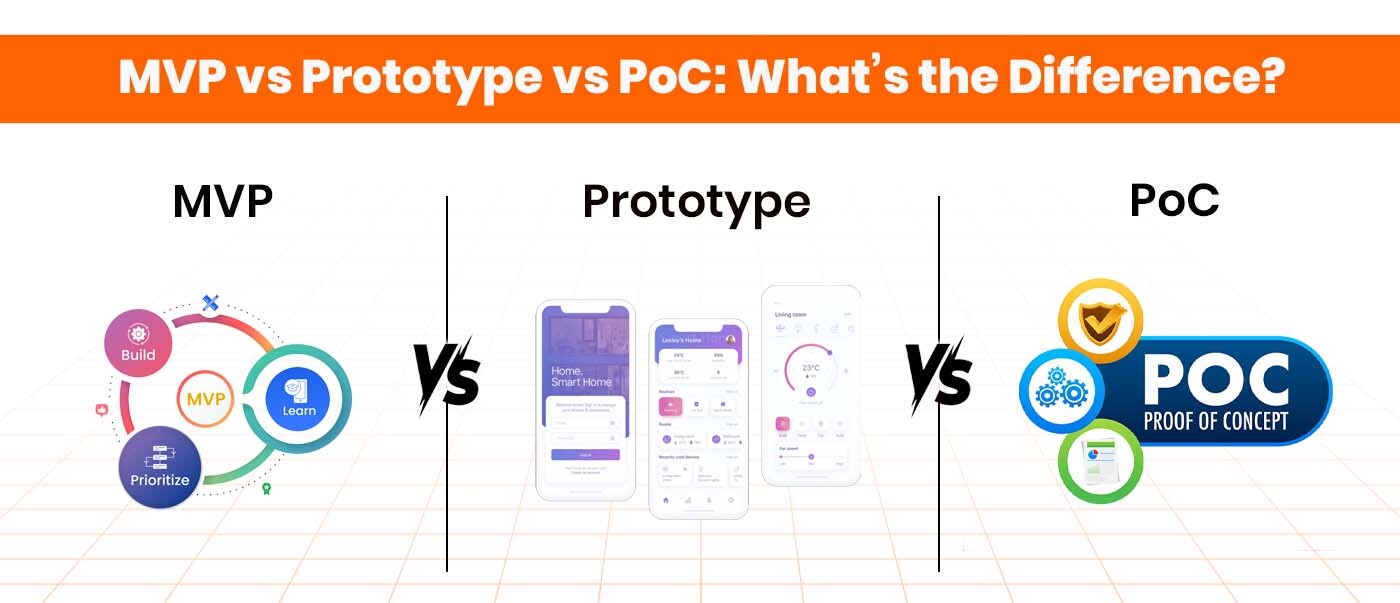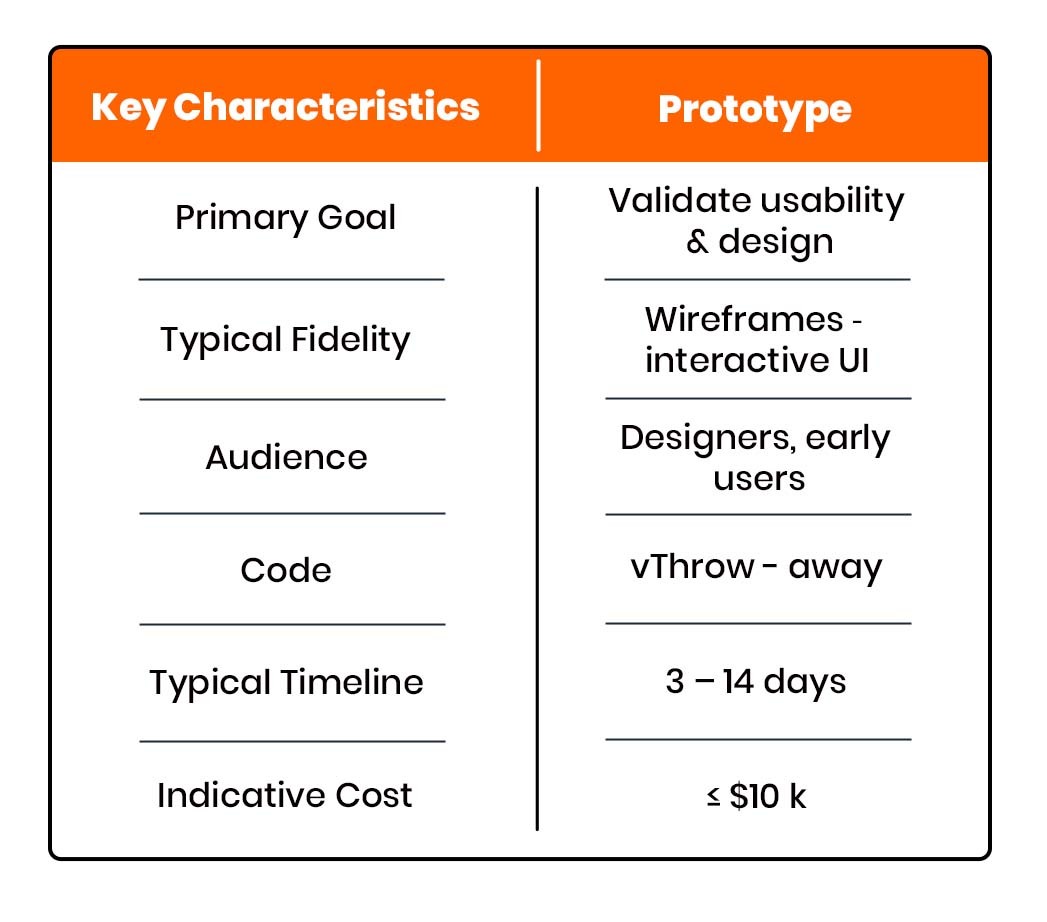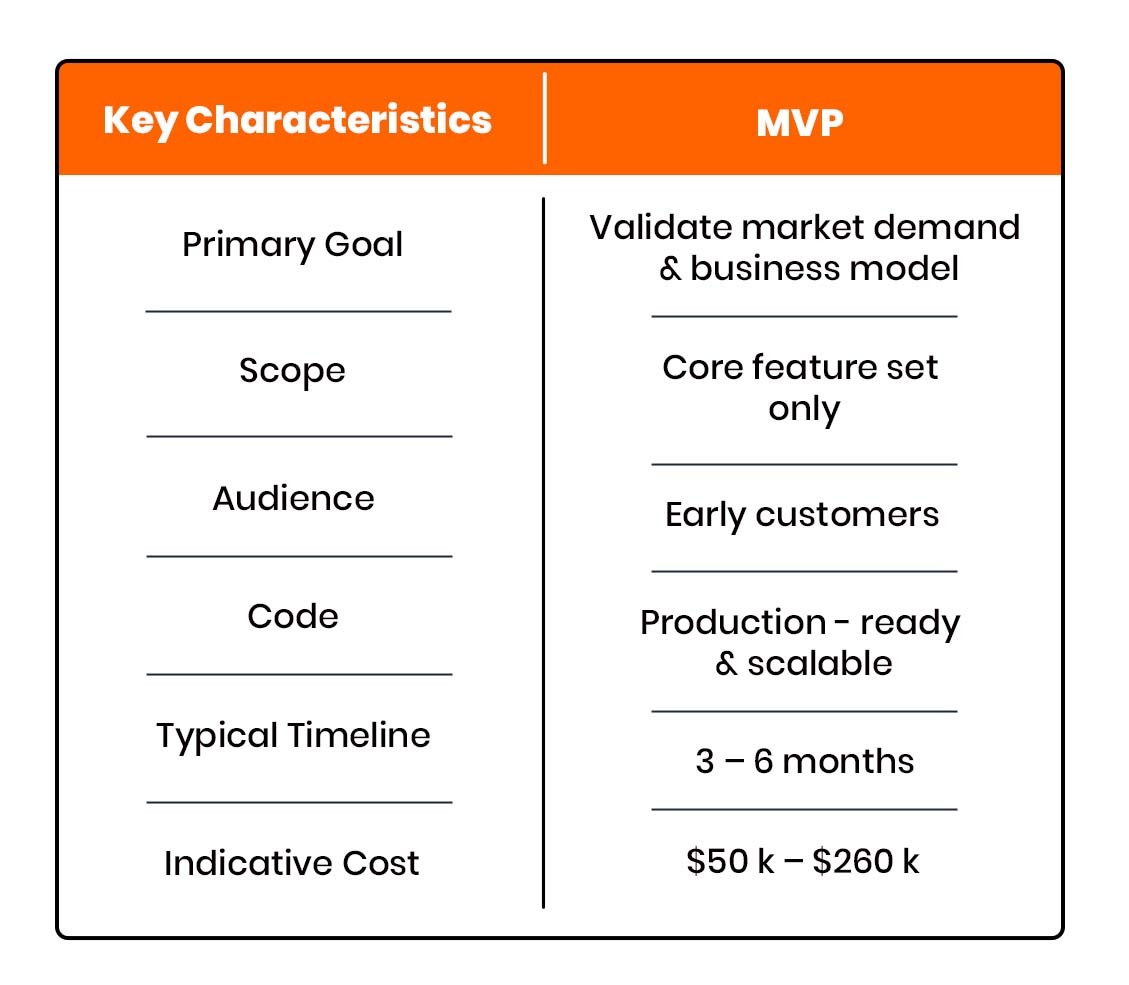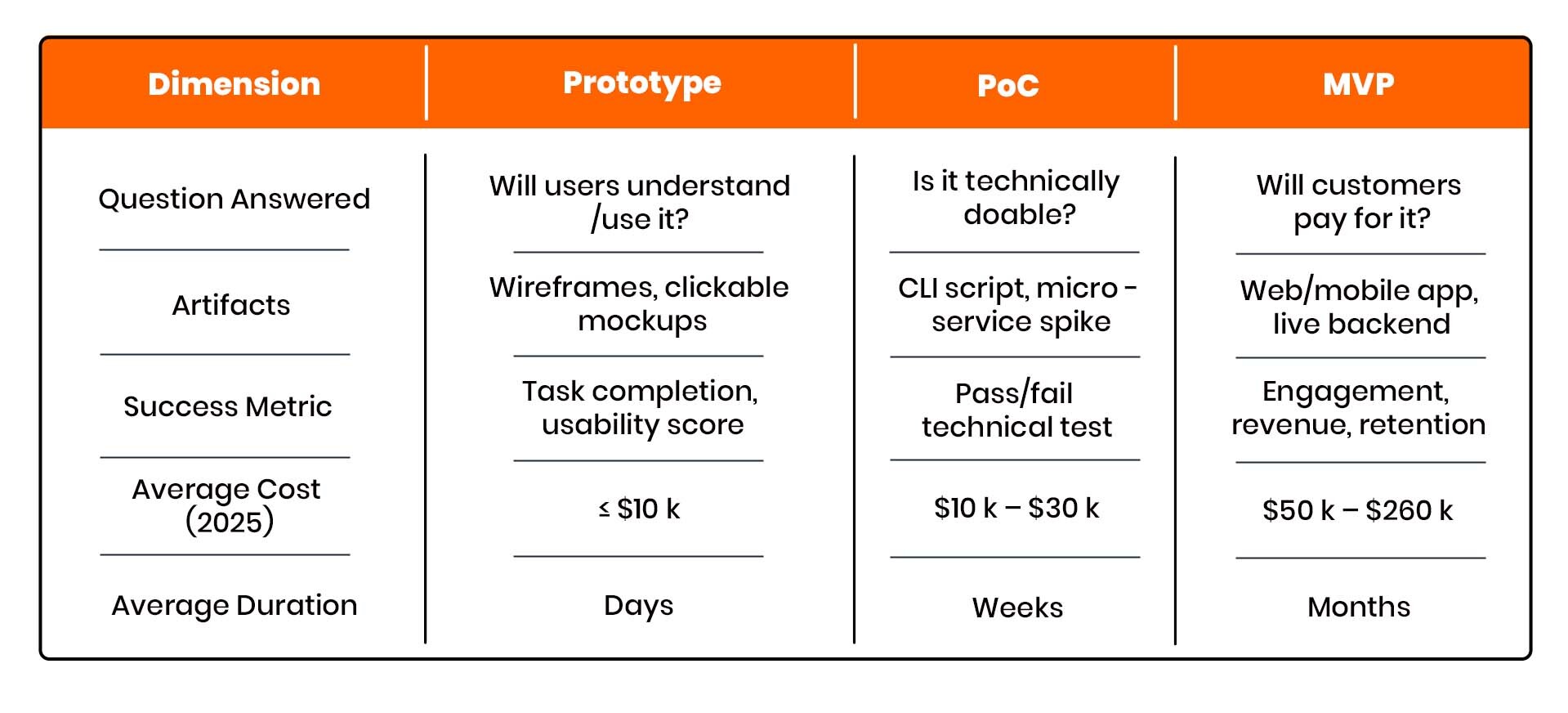MVP vs Prototype vs PoC: What’s the Difference?
Confused about MVP, Prototype, or PoC? Get the complete comparison with timelines, costs, real examples, and when to use each. Rank your product idea right.

Have you ever pitched a product idea and been asked, “Is this your MVP or just a prototype?” According to CB Insights, the confusion is costly: 42 % of failed startups cite “no market need” as the top reason for shutdown often because teams validated the wrong thing at the wrong time.
This guide cuts through the noise with data‑backed insights so you can choose the right validation tool, reduce waste, and reach product‑market fit faster.
What Is a Prototype?
A prototype is a visual or functional draft used to test user flows, design ideas, and overall experience before writing any production code. Think of it as a quick way to answer: "Will users get it?"
As rapid prototyping tools gain popularity, the global market is expected to reach $1.48 billion by 2025 (CAGR 23.7%), per The Business Research Company. That’s a sign: design validation is no longer optional.

What Is a Proof of Concept (PoC)?
A Proof of Concept (PoC) answers a very different question: "Is this technically feasible?"
It’s a narrow engineering experiment that isolates a complex or risky technical assumption. Unlike prototypes, PoCs are less about user experience and more about backend guts.
In the European Research Council’s 2023 PoC program, only 43 % of proposals were funded, underscoring the high bar for technical feasibility.

What Is a Minimum Viable Product (MVP)?
An MVP is a production-ready version of your product that includes just enough features to deliver value to early adopters and validate if the market wants what you’re building.
Unlike prototypes and PoCs, MVPs go live. They get real users, generate feedback, and often become the foundation for the final product.
Current benchmarks show:
-
3‑4 months is the ideal build window for most MVPs, extending to 6–12 months for complex domains.
-
2025 market data places typical MVP budgets between $47K and $260K depending on scope, team location, and complexity

MVP vs Prototype: Why the Confusion Happens
The terms "MVP" and "Prototype" often get used interchangeably, but they serve very different purposes in product development. A prototype is meant to test how something looks and feels, while an MVP is about whether it solves a real-world problem and if people will pay for it.
If you're building to show design, go prototype. If you're building to ship and learn from users, go MVP.
Example: A Figma mockup of your new app is a prototype. A live, stripped-down version of that app that users can log into and use? That’s an MVP.
Understanding this "mvp prototype difference" helps streamline communication between product, design, and engineering and avoids wasted sprints.
MVP vs PoC: What’s at Stake?
Here’s where the distinction becomes crucial. A PoC is about proving if something can be built. An MVP is about proving if something should be built.
For instance, say you want to use AI to summarize meeting notes. A PoC would involve writing a script using an LLM API to check if the summaries are accurate. But to know if teams will pay for this as a product, you’ll need an MVP: a simple UI, login flow, and usage tracking.
PoC = internal tech validation.
MVP = external market validation.
Skipping the "mvp vs poc" conversation early can lead to over-engineered products that no one ends up using.
MVP vs Prototype vs PoC: Tabular Comparison

Real‑World Examples

What Makes the MVP Prototype Difference So Critical?
Getting this difference wrong isn’t just a terminology issue, it’s a budget killer. If you invest MVP-level resources into a prototype, you risk polishing something that was never meant to ship. And if you treat an MVP like a throwaway prototype, you may lose early users due to bugs, poor performance, or lack of trust.
Prototypes are built for learning design.
MVPs are built for learning what users will actually adopt.
Think of prototypes as the blueprint and MVPs as the first live floor of your product. Mixing them up leads to structural misalignment that can cost months of rebuild time later.
When to Use What: A Decision Framework
If you're staring at a whiteboard full of unknowns, here's your cheat sheet:
-
Is design risk high? Start with a Prototype.
-
Are there technical unknowns? Do a PoC.
-
Need proof people will pay? Build an MVP.
If you face all three, follow this order: Prototype → PoC → MVP.
Why? Because the earlier the gate, the cheaper the failure.
Key Takeaway: Validate Smart, Scale Fast
The smartest teams don’t skip steps. They validate the right things in the right order. Doing so cuts wasted time, reduces cost, and gives your product the best chance at product-market fit.
Whether you're a startup founder or an enterprise product lead, understanding the differences between MVP, Prototype, and PoC is more than semantics. It's strategy.
Need help mapping it all out? At VoxturrLabs, we build high-impact MVPs, guide PoC development, and design intuitive prototypes.

FAQs
1. What is the MVP full form in software development?
MVP stands for Minimum Viable Product, the simplest usable version of a product to test real demand.
2. What’s the actual MVP meaning for startups?
MVP means launching lean. Build only the core features, get feedback, then iterate based on real user needs.
3. Is a prototype the same as an MVP?
No. A prototype tests usability, often without real code. An MVP is a working product used by real customers.
4. Can you get funding with just a PoC?
Yes, especially in deep tech. Investors often fund PoCs that prove technical innovation or feasibility.
5. Should I skip straight to MVP?
Only if you’ve already validated design and technical risk. Otherwise, start small and validate each layer.

Gaurav Lakhani is the founder and CEO of Voxturrlabs. With a proven track record of conceptualizing and architecting 100+ user-centric and scalable solutions for startups and enterprises, he brings a deep understanding of both technical and user experience aspects. Gaurav's ability to build enterprise-grade technology solutions has garnered the trust of over 30 Fortune 500 companies, including Siemens, 3M, P&G, and Hershey's. Gaurav is an early adopter of new technology, a passionate technology enthusiast, and an investor in AI and IoT startups.

Ready for a Next-Level of Enterprise Growth?
Let's discuss your requirements
You May Also Like

MVP
MVP vs MLP: What's the Right Product Strategy for Your Startup in 2025?
How to decide whether to launch lean with an MVP or launch lovable with an MLP, with real examples, cost ranges, and a practical decision framework.
23 min read

MVP
The Complete Guide to MVP Development for Startups
Learn MVP development for startups with this step by step guide to build, test, and launch your product faster while reducing risks.
10 min read

MVP
How to Build an MVP in 3–6 Months: A Step-by-Step Guide
Build your MVP in just 3 to 6 months with VoxturrLabs’ proven step-by-step guide. Learn timelines, team structure, agile sprints & MVP best practices to launch faster.
9 min read

MVP
What is an MVP? Full Form and Meaning in Software Development
Discover the MVP meaning in software development. Learn how a Minimum Viable Product helps startups validate ideas, save resources, and scale smarter.
8 min read

MVP
MVP Development for Startups: Get Your Business Off to a Stellar Start
It’s a fact that in this dynamic and turbulent world full of brilliant ideas ready to be born into great startups, every entrepreneur faces the same challenge – a blank page because they ignore MVP development! That is one of the primary reasons why about
9 min read
Start a conversation by filling the form
Once you let us know your requirement, our technical expert will schedule a call and discuss your idea in detail post sign of an NDA.